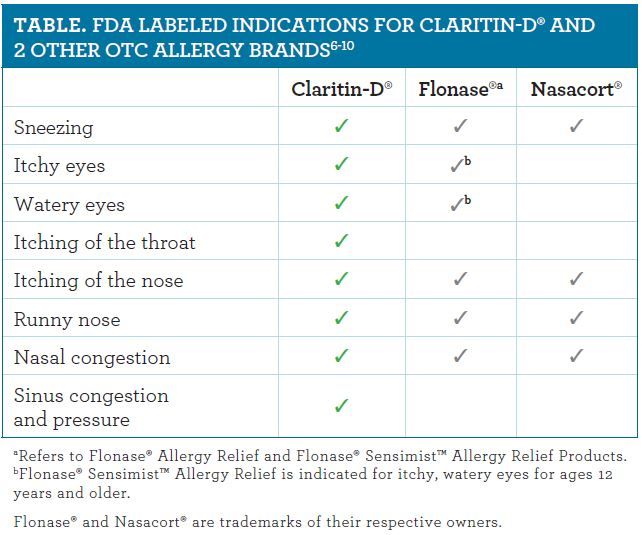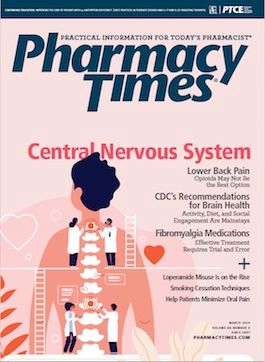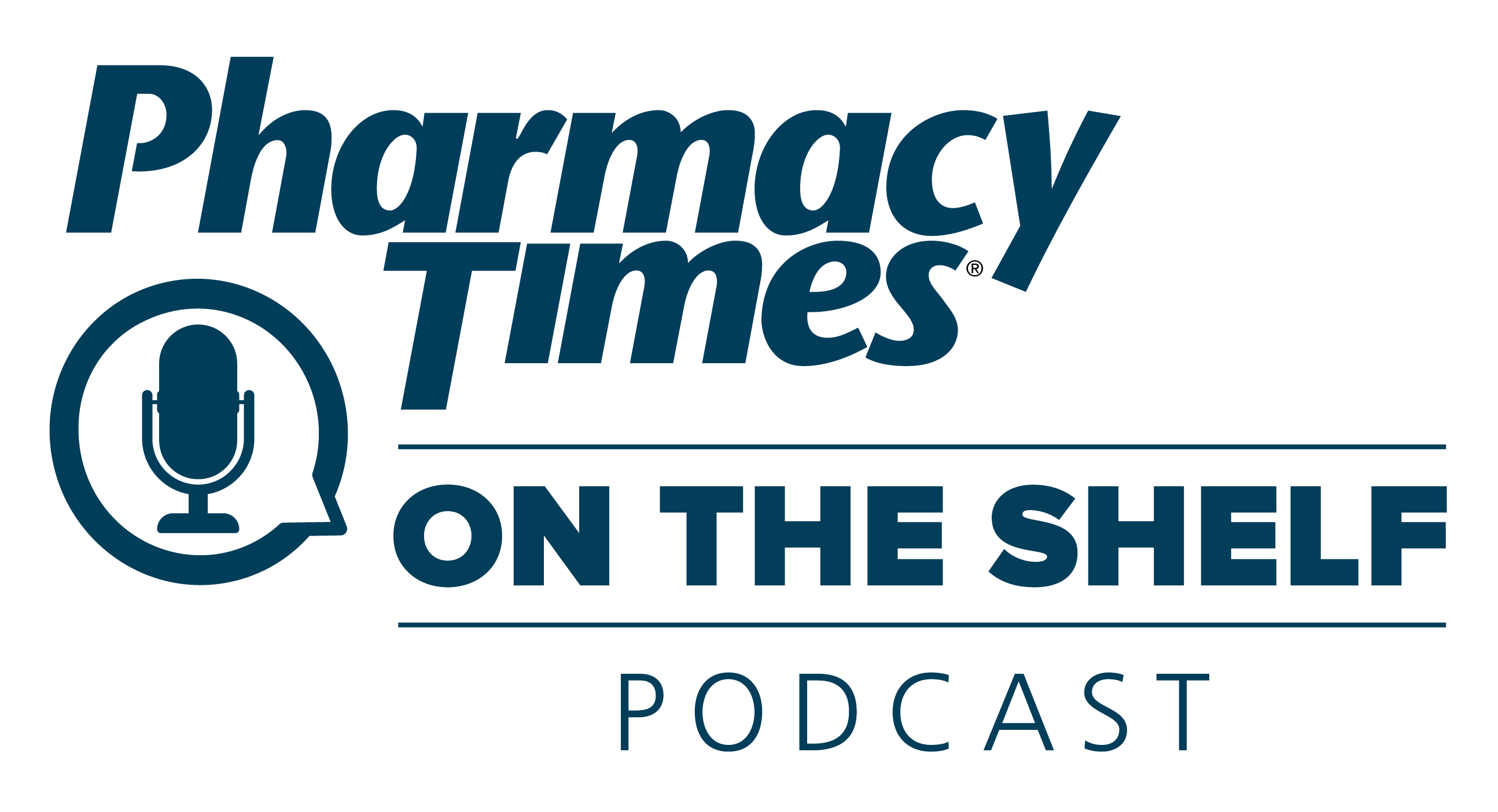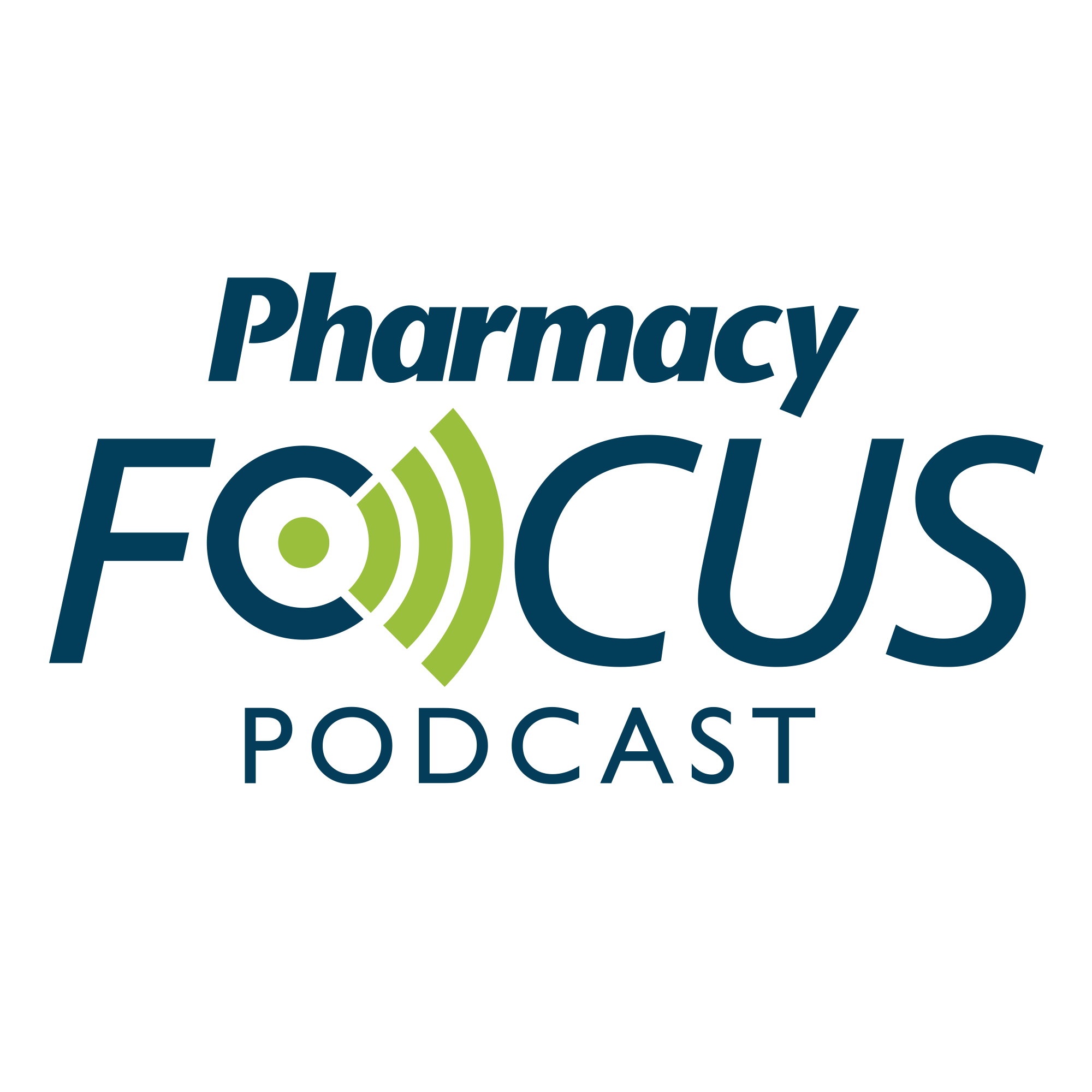Publication
Article
Pharmacy Times
Considerations of Claritin-D® for Nasal Allergy Symptom Relief
Produced by Pharmacy Times® with Bayer.
In individuals with allergies, exposure to indoor allergens (ie, pet dander and dust mites) and outdoor allergens (ie, pollen and mold spores) will trigger a range of symptoms that can persist year-round, including itchy and watery eyes; runny nose; sneezing; nasal itching; nasal congestion; and sinus pressure.1 Allergy symptoms can interfere with daily activities and adversely affect physical and emotional well-being.1-3
Nasal congestion can be particularly burdensome as blocked nasal passages can restrict airflow through the nose and make breathing difficult.1,2 In a survey of American adults with nasal and ocular seasonal allergy symptoms (N = 500), the symptoms that respondents rated as most severe were nasal congestion (46%) and stuffy nose (33%).2 More than 60% of respondents reported managing their allergy symptoms with an OTC allergy medication.2
There are many OTC product options available for allergy symptom relief in numerous formulations including antihistamines, nasal decongestants, and intranasal corticosteroid (INS) sprays.3,4 As these products provide relief from certain allergy symptoms, consumers may have additional questions regarding their symptoms.1,4,5 Pharmacists are well-positioned to provide counseling to consumers if requested.
CONSIDERATIONS IN THE SELECTION OF AN OTC ALLERGY MEDICATION
It is important for pharmacists to be aware of the different FDA approved indications and product specific features of the leading allergy brands available in the pharmacy. To support counseling and product selection, the TABLE provides information regarding the INS sprays Flonase® (fluticasone propionate) and Nasacort® (triamcinolone acetonide), and Claritin-D® tablets, which combine an antihistamine (loratadine) and a nasal decongestant (pseudoephedrine sulfate).6-10

Differences in FDA-Approved Indications and Allergy Symptom Relief
INS sprays temporarily relieve symptoms of hay fever or other upper respiratory allergies including nasal congestion, runny nose, sneezing, itchy nose, and certain INS products also relieve itchy, watery eyes.8-10 Claritin-D® has 8 indications, including the temporary relief of itchy throat and sinus congestion and pressure, which are not addressed by INS sprays.6-10
The antihistamine in Claritin-D® temporarily relieves common allergy symptoms including runny nose, sneezing, itchy and watery eyes, and itching of the nose and throat.6,7 The nasal decongestant in Claritin-D® reduces swelling of nasal passages and temporarily restores nasal airflow through the nose. Claritin-D® temporarily relieves nasal congestion due to the common cold, hay fever, or other upper respiratory allergies and also relieves sinus congestion and pressure due to allergies.6,7
Fast Relief of Nasal Congestion
Important considerations that guide the selection of an OTC allergy medication are product effectiveness and fast-acting therapeutic activity to provide quick relief.2 INS sprays can provide relief from nasal congestion; however, the onset of therapeutic effect is within approximately 12 hours and they provide maximum relief when used consistently for several days.1,3,8-11 Because the steroid medication in an INS is solubilized into an aqueous medium, the INS spray may coat nasal passages and provide a feeling, similar to using a saline nasal spray; however, the steroid does not exert a therapeutic effect immediately.1
For those with nasal congestion symptoms, Claritin-D® is an option that starts working on nasal congestion in as little as 30 minutes.6,7,12-14
Nasal Airflow Changes With Claritin-D®
In a phase 4, randomized, 4-way crossover study (NCT03443843), Claritin-D® improved nasal airflow compared with Flonase® nasal spray after the first dose.13,14 The study enrolled patients with established seasonal allergic rhinitis and demonstrated response to ragweed pollen; eligible patients had allergy symptoms that included nasal congestion.13,14 To induce allergy symptoms, patients (N = 82) were exposed to standardized levels of ragweed pollen within an environmental exposure unit, a validated method that provides a controlled, stable, and reproducible environment.13-15
Patients were randomized (1:1:1:1) to receive either a single oral dose of Claritin-D® 12 Hour (loratadine 5 mg/pseudoephedrine 120 mg), a placebo tablet, 2 sprays per nostril of Flonase® nasal spray (50 mcg per spray), or 2 sprays per nostril of a placebo nasal spray. The trial was designed with 4 experimental sequences and the crossover treatment design allowed patients to receive each of the 4 study treatments across 4 treatment visits, separated by 14-day intervals.13,14
Peak nasal inspiratory flow (PNIF) directly measures nasal airflow through the nose in liters per minute during maximal inspiration. Nasal airflow measurements has been used as an outcome measure in the assessment of INS sprays and cough, cold, and allergy products that contain the nasal decongestant pseudoephedrine.16-21 The study assessed the average percent change in PNIF from pre-dose to 4 hours after dosing, measured every 30 minutes from 0 to 4 hours.13,14
In the analysis of the per-protocol population (N = 77), the average percent change in PNIF from pre-dose to 4 hours after dosing in the Claritin-D® treatment group was 31.3% compared with 14.8% in the Flonase® treatment group and 11.6% in the group receiving placebo tablet. In the study, a single dose of Claritin-D® significantly improved nasal airflow compared with placebo tablet (P <.001). Claritin-D® significantly improved nasal airflow compared with Flonase® nasal spray (P <.001). Based on peak intake after the first dose, Claritin-D® improved nasal airflow 2 times more than Flonase® nasal spray at hour 1 (P <.05).13,14
ROLE OF THE PHARMACIST
As health care professionals readily accessible to consumers in community settings, pharmacists are a helpful resource for additional education on OTC products. Consumers may ask the pharmacist for an OTC product recommendation for fast relief of their allergy symptoms.
Pharmacists have an opportunity to recommend Claritin-D® based on the 8 labeled indications including sneezing, runny nose, nasal congestion, itchy nose, itchy eyes, watery eyes, itchy throat, and sinus congestion and pressure.6,7 Pharmacists can also note that Claritin-D® tablets are available in 12-hour and 24-hour formulations and that because it contains the second generation antihistamine, loratadine, Claritin-D® provides non-drowsy symptom relief.6,7 For those with allergy symptoms that include nasal congestion, pharmacists can provide additional education that in a clinical trial, Claritin-D® improved nasal airflow 2 times more than the leading allergy spray (fluticasone propionate nasal spray) at hour 1, based on peak intake after the first dose.13,14
It is also important for pharmacists to be aware of OTC allergy product warnings. Those with heart disease, thyroid disease, high blood pressure, diabetes, trouble urinating due to an enlarged prostate gland, and liver or kidney disease should consult their provider before use of Claritin-D®. Claritin-D® should be stopped in cases of allergic reaction; if symptoms do not improve within 7 days or are accompanied by a fever; or if nervousness, dizziness, or sleeplessness occur.6,7
By supporting consumers with additional education regarding OTC allergy relief products, pharmacists can assist with selection of the right product.
REFERENCES
1. Understanding Allergies: Allergy & Asthma Today Special Edition. Allergy & Asthma Network; Vienna, VA: 2016.
2. Meltzer EO, Farrar JR, Sennett C. Findings from an online survey assessing the burden and management of seasonal allergic rhinoconjunctivitis in US patients [published online November 30, 2016]. J Allergy Clin Immunol Pract. 2017;5(3):779-789.e6. doi: 10.1016/j.jaip.2016.10.010.
3. Dykewicz MS, Wallace DV, Baroody F, et al. Treatment of seasonal allergic rhinitis: an evidence-based focused 2017 guideline update [published online November 2, 2017]. Ann Allergy Asthma Immunol. 2017;119(6):489-511.e41. doi: 10.1016/j.anai.2017.08.012.
4. Seidman MD, Gurgel RK, Lin SY, et al; Guideline Otolaryngology Development Group. AAO-HNSF. Clinical practice guideline: allergic rhinitis. Otolaryngol Head Neck Surg. 2015;152(suppl 1):1-43. doi: 10.1177/0194599814561600.
5. Tan R, Cvetkovski B, Kritikos V, et al. Identifying the hidden burden of allergic rhinitis (AR) in community pharmacy: a global phenomenon. Asthma Res Pract. 2017;3:8. doi: 10.1186/s40733-017-0036-z.
6. Claritin-D 12 Hour Tablets drug facts. Bayer website. claritin.com/media/e6580f4dda5b4ca9b70b506742b97ac4.ashx. Published April 8, 2015. Accessed January 10, 2020.
7. Claritin-D 24 Hour Tablets drug facts. Bayer website. claritin.com/media/24c6f201d95a4520b7f953ab29684e9b.ashx. Published April 8, 2015. Accessed January 10, 2020.
8. Flonase drug facts. GlaxoSmithKline website. flonase.com/products/flonaseallergy-relief/drug-facts/. Published 2018. Accessed January 10, 2020.
9. Flonase Sensimist Allergy Relief drug facts. GlaxoSmithKline website. flonase.com/products/sensimist/drug-facts/. Published 2018. Accessed January 13, 2020.
10. Nasacort Allergy 24HR drug facts. Chattem Inc website. nasacort.com/hcp/pdf/Nasacort_Drug_Facts_Label.pdf. Accessed January 13, 2020.
11. Meltzer EO, Rickard KA, Westlund RE, Cook CK. Onset of therapeutic effect of fluticasone propionate aqueous nasal spray. Ann Allergy Asthma Immunol. 2001;86(3):286-291.
12. Georgitis JW, Meltzer EO, Kaliner M, Weiler J, Berkowitz R. Onset-of-action for antihistamine and decongestant combinations during an outdoor challenge. Ann Allergy Asthma Immunol. 2000;84(4):451-459.
13. A Double-Blind Placebo-Controlled Crossover Study to Evaluate Objective Changes in Nasal Airflow of Loratadine/Pseudoephedrine Tablet and Fluticasone Propionate Nasal Spray in Subjects Following Allergen Exposure in an Environmental Exposure Unit. ClinicalTrials.gov website. clinicaltrials.gov/ct2/show/NCT03443843. Last Updated December 20, 2019. Accessed January 8, 2020.
14. A study to evaluate changes in nasal airflow of Loratadine/Pseudoephedrine tablet and Fluticasone Propionate nasal spray in subjects following allergen exposure. Bayer Clinical Trials website. clinicaltrials.bayer.com/study/2417. Published April 5, 2019. Accessed January 8, 2019.
15. Day JH, Briscoe MP. Environmental exposure unit: a system to test anti-allergic treatment. Ann Allergy Asthma Immunol. 1999;83(2):83-89.
16. Taverner D, Danz C, Economos D. The effects of oral pseudoephedrine on nasal patency in the common cold: a double-blind single-dose placebo-controlled trial. Clin Otolaryngol Allied Sci.1999;24(1):47-51. doi: 10.1046/j.1365-2273.1999.00208.x.
17. Horak F, Zieglmayer P, Zieglmayer R, et al. A placebo-controlled study of the nasal decongestant effect of phenylephrine and pseudoephedrine in the Vienna Challenge Chamber. Ann Allergy Asthma Immunol. 2009;102(2):116-120. doi: 10.1016/S1081-1206(10)60240-2.
18. Eccles R, Jawad MS, Jawad SS, Angello JT, Druce HM. Efficacy and safety of single and multiple doses of pseudoephedrine in the treatment of nasal congestion associated with common cold. Am J Rhinol. 2005;19(1):25-31.
19. Eccles R, Voelker M. Analgesic and decongestant efficacy of the combination of aspirin with pseudoephedrine in patients with symptoms of upper respiratory tract infection. Clin Pharmacol Drug Dev. 2014;3(2):118-125. doi: 10.1002/cpdd.39.
20. Day JH, Briscoe MP, Rafeiro E, Ellis AK, Pettersson E, Akerlund A. Onset of action of intranasal budesonide (Rhinocort aqua) in seasonal allergic rhinitis studied in a controlled exposure model. J Allergy Clin Immunol. 2000;105(3):489-494. doi: 10.1067/mai.2000.104550.
21. Bende M, Carrillo T, Vóna I, da Castel-Branco MG, Arheden L. A randomized comparison of the effects of budesonide and mometasone furoate aqueous nasal sprays on nasal peak flow rate and symptoms in perennial allergic rhinitis. Ann Allergy Asthma Immunol. 2002;88(6):617-623. doi: 10.1016/s1081-1206(10)61894-7.







